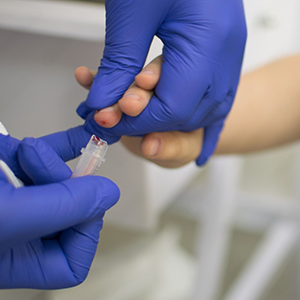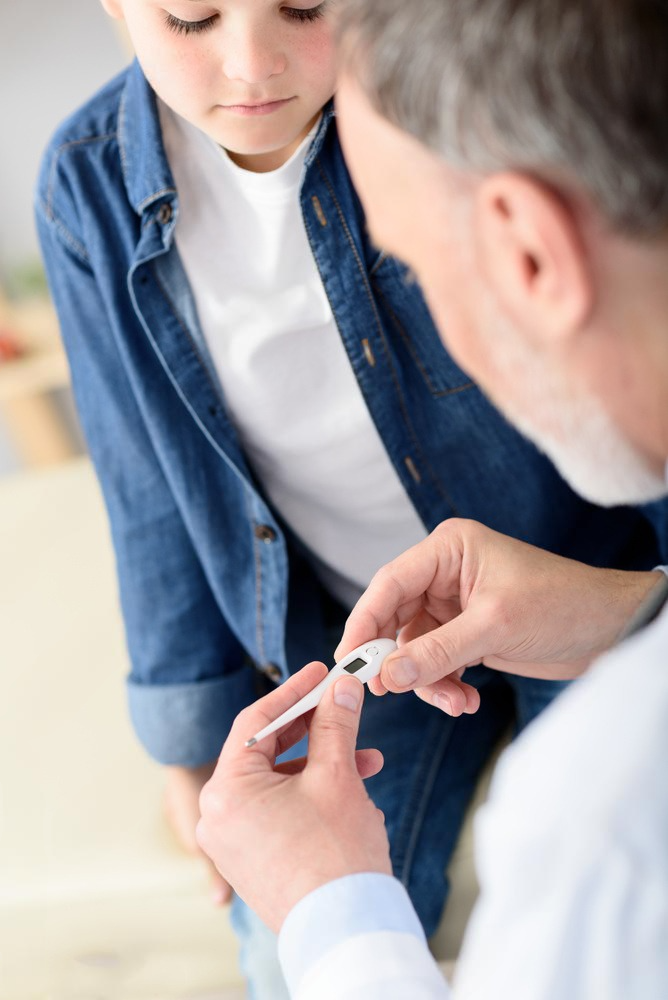Faster, Safer Diagnosis for Feverish Children
A rapid blood-based miRNA test that rules out serious bacterial infections, helping clinicians act confidently.

The Challenge
Why Diagnosing Fevers in Children Is So Hard
- Over half of ED visits for young kids involve fever
- In infants < 3 months, any fever is a medical emergency
- Symptoms and current labs (CRP, cultures) can take hours–days and still be inconclusive
Fever can mean many different things — from a harmless cold to a life-threatening bacterial infection. In babies under 3 months old, even a mild fever is classified as a medical emergency. That’s because their immune systems aren’t fully developed, and it’s extremely difficult to tell if something serious is going on.

Explainer Video
Want to know how it works?
Watch this short video to learn how BAC Check helps you stay informed and in control.
Fast, simple, and built for everyday use.
The Cost of Overprescribing
When ‘Just in Case’ Harms More Than It Helps
The decision on treatment usually needs to be made within the first 3 hours of arriving at hospital, doctors can’t always wait for lab test results to come back — they have to act quickly, sometimes with limited information. But in most cases, the infection turns out to be viral, not bacterial — and antibiotics don’t help viral infections.
65 % of febrile children get antibiotics in the ED—but only 13 % actually need them.
By reducing the unnecessary use of antibiotics we will see:
Fewer side-effects (rashes, diarrhea, allergies).
Protects the gut microbiome (reducing long-term risks: asthma, obesity).
Slows antimicrobial resistance.
Our Solution
Right now, there are no fast, reliable tests that can clearly tell if a child with fever has a serious bacterial infection – especially in the early stages. Reducing unnecessary antibiotic use is a global health priority.
We’ve developed a new type of blood test that looks for specific patterns of microRNAs (miRNAs) — tiny molecules in the blood that change rapidly when the body is fighting an infection or other types of disease. The test helps ensure that no child at risk is missed.

Detects specific miRNA patterns to rule out bacterial infection
If the test is negative:
Combined with clinical examination and other tests, doctors can confidently withhold antibiotics.
If the test is positive or inconclusive:
Doctors will continue with current best practice — which may include giving antibiotics.

Requires just 100 microlitres blood—safe for newborns
This test gives doctors better information, faster — so they can make safer, more accurate decisions for your child.
Rather than giving antibiotics to everyone “just in case,” this test helps identify the children who truly need them — and protects the rest from unnecessary treatment.

Results in hours, not days
Tests, like blood cultures, can take up to 3 days to return results. However a decision on antibiotics needs to be made in just a few hours.
Our miRNA test is designed to help doctors rule out serious bacterial infection — it doesn’t replace clinical judgment but adds a powerful piece of evidence to support decisions.
The Process
Collection of tiny
blood sample
Small-volume assay — requires only 100μL plasma, suitable for neonates and infants
miRNA extraction
& profiling
Utilises validated miRNA biomarkers associated with SBI/IBI. Capable of discriminating between infection and inflammation
Automated result: “Bacterial Infection: Likely / Unlikely”
Rapid turnaround (compatible with current lab infrastructure or future point-of-care adaptation)

For Healthcare Professionals & Parents
Designed for Clinical Decision-Making, Providing Peace of Mind for Parents
- Aligns with NICE antibiotic use guidelines
- Aligns with WHO stewardship goals
- Reduce need for lumbar puncture & empiric antibiotics
- Supports rapid triage in early presentations
Especially useful in early presentations where the child is systemically well-appearing but concern remains for underlying SBI/IBI.
About Bac Check
We’re a team of researchers and clinicians at Queen’s University Belfast
Early findings suggest:
It could provide additional diagnostic clarity within the crucial early hours. It may support clinicians in safely avoiding unnecessary antibiotics. But the tool is still in development — and before going further, we’re looking to understand if this kind of test would be useful, feasible, and acceptable in real clinical or diagnostic settings.
Partner with us
A Conversation About Improving Paediatric Fever Diagnosis
We’re exploring a new approach to diagnosing serious bacterial infections in children — and we’d value your insights.
Reducing unnecessary antibiotic use is a clinical, operational, and public health priority — and safer, faster diagnostics are a key part of the solution. If you’re also exploring ways to improve fever triage in children, we’d welcome your perspective.
Whether through integration into hospital diagnostics or point-of-care expansion, Bac Check offers a first-mover advantage in a high-need, under-served segment.

Survey Links
Patients
Parents
Healthcare
Providers
Potential Collaborators
Contact
Join Us in Transforming Pediatric Fever Care
We’re not selling anything right now. We’re genuinely looking to learn from others in the field and better understand how (or if) a test like Bac Check might serve a real need.
If you’re open to a short conversation — or would be happy to share your thoughts via email or survey — we’d be hugely grateful.
- Queens University Beflast
